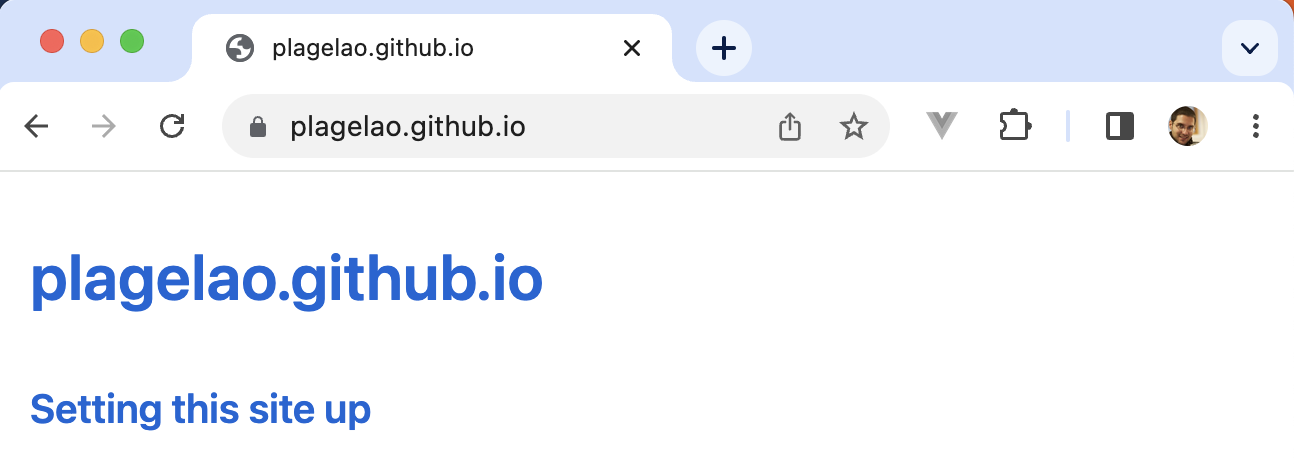Setting this site up
July 2023
Having a personal site is a great way to keep learning and growing. When you write about different things, you become more knowledgeable. It also helps you get better at expressing yourself through writing, and it’s a lot of fun too. Writing on your personal site encourages you to think about yourself and your goals, which can be really helpful for your career.
Let’s get on with it!
Why GitHub Pages?
Many developers already have a GitHub account, and GitHub Pages has been around since 2008. A lot of sites use it and it seems like a good option.
Whenever you start with something new, you need to start by following the documentation. In this case, the documentation was the GitHub guide to create the site. Turns out that the documentation is clear and creating the basic site was straightforward. It took a couple of minutes.

The next step was understanding how pushing a new post works. That was the first blocker.
How to push a new post
Following the pattern of the index.md that GitHub Pages explains in their documentation, the next step was to create a new file my-new-post.md. After pushing it, the post wasn’t visible in the home page, but it existed in /my-new-post. Although it was a step in the right direction, the goal was to display the list of posts in the home page so visitors could find them.
How to list the posts: The wrong way
It was a mistake to start assuming things without reading the documentation. This time, it was the Jekyll documentation. It says that depending on how you name your files, Jekyll can infer the publication date and create a URL for that item that contains the date. For example, in the previous step, the name of the post file was my-new-post.md and that created the URL /my-new-post. What the documentation said is that if you name your file 2023-07-26-my-new-post, it generates the following URL /2023/07/26/my-new-post. It’s always useful to have the date of publication of an article, mostly because technical articles are likely to become obsolete in a year or two.
After pushing those changes… nothing. No posts in the home page. At least the post URL now had the date in it though.
How to list the posts: Wrong again
Checking the documentation again, it says how to list the posts in a page. You need to add a bit of code to the page:
{% for post in site.posts %}
<article>
<h3><a href="{{ post.url }}">{{ post.title }}</a></h3>
</article>
{% endfor %}
This looks good, it makes sense. After pushing again… Nothing showed up :(
How to list the posts: The correct way
Back to the Jekyll documentation. It turns out that the site.posts code infers the posts from the files in the _posts directory. This works by default in Jekyll but, in GitHub Pages, it also works because of the theme it uses. The theme is important for later, but for now note that the theme it uses is Primer.
After moving the post file to the correct directory, and after another push, this time the post showed up in the homepage.

Customizing the theme
Primer is a theme that aims for simplicity. It looks good, but your personal blog needs a bit of customization. Anything you need to know on how to customize it’s explained in the Primer GitHub ReadMe page.
Reflecting on “the process”
From this experience, it looks like GitHub Pages and Jekyll follow the principle of least surprise. Most of the blocks in the article took minutes to unblock and the solutions make sense.
The problem I had is that starting with a new technology/framework/language/whatever is never straightforward, but it looks like it after the fact.
This problem takes many forms in software development. From seniors that can’t communicate effectively with juniors, to engineers that can’t explain technical things to non-technical stakeholders, and even you beating up yourself for the latest bug in production when it was so clear that the code was wrong. It shows a lack of empathy that’s, unfortunately, common in software development. There isn’t a fast solution to this problem, but the more aware we’re about it, the better.